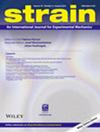冲击速度和冲击角度对异物损伤残余应力场的影响
IF 2.4
3区 材料科学
Q2 MATERIALS SCIENCE, CHARACTERIZATION & TESTING
引用次数: 6
摘要
为了研究异物损伤(FOD)引起的残余应力,采用同步加速器X射线sin2ψ技术测量了硬球体撞击引起的残余应力分布。将一个钢球以180米/秒的速度以90°或45°的角度撞击到Ti - 6Al - 4V合金的平面上。同样的球体也被准静态地压入表面。在直角撞击和准静态压痕的情况下,残余压应力在形成的坑内广泛分布。在动态情况和准静态情况下,残余应力分布没有显著差异。然而,在45°冲击角时,弹坑内部广泛分布着对疲劳强度更不利的拉残余应力。在陨石坑外,拉应力在所有情况下都普遍存在。本文章由计算机程序翻译,如有差异,请以英文原文为准。
Effect of impact velocity and impact angle on residual stress fields caused by foreign object damage
In order to study the residual stress induced by foreign object damage (FOD), the distribution of residual stress caused by the impact of a hard spherical body was measured via the sin2ψ technique, using synchrotron X‐ray. A steel sphere was impacted onto a flat surface of a Ti‐6Al‐4V alloy from an angle of either 90° or 45°, at a velocity of 180 m/s. The same sphere was also quasi‐statically pressed into the surface. In the cases of right‐angled impact and quasi‐static indentation, a compressive residual stress was extensively distributed inside the generated crater. No remarkable difference in residual stress distribution was noted between the dynamic case and the quasi‐static case. However, at an impact angle of 45°, a tensile residual stress that is more detrimental to fatigue strength was widely distributed inside the crater. Outside of the craters, tensile stress was generally observed in all cases.
求助全文
通过发布文献求助,成功后即可免费获取论文全文。
去求助
来源期刊

Strain
工程技术-材料科学:表征与测试
CiteScore
4.10
自引率
4.80%
发文量
27
期刊介绍:
Strain is an international journal that contains contributions from leading-edge research on the measurement of the mechanical behaviour of structures and systems. Strain only accepts contributions with sufficient novelty in the design, implementation, and/or validation of experimental methodologies to characterize materials, structures, and systems; i.e. contributions that are limited to the application of established methodologies are outside of the scope of the journal. The journal includes papers from all engineering disciplines that deal with material behaviour and degradation under load, structural design and measurement techniques. Although the thrust of the journal is experimental, numerical simulations and validation are included in the coverage.
Strain welcomes papers that deal with novel work in the following areas:
experimental techniques
non-destructive evaluation techniques
numerical analysis, simulation and validation
residual stress measurement techniques
design of composite structures and components
impact behaviour of materials and structures
signal and image processing
transducer and sensor design
structural health monitoring
biomechanics
extreme environment
micro- and nano-scale testing method.
 求助内容:
求助内容: 应助结果提醒方式:
应助结果提醒方式:


